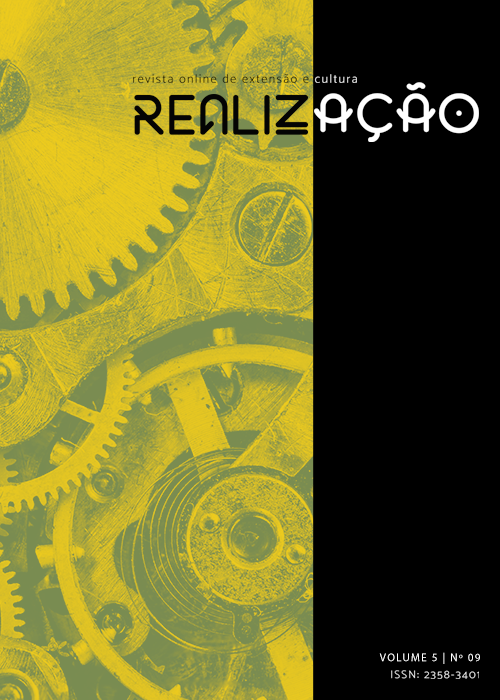Environmental education: natural resources in transformation, soil and the environment
DOI:
https://doi.org/10.30612/re-ufgd.v5i9.8544Keywords:
Natural resources, Agroecology, LifeAbstract
Given realities such as the scarcity of natural resources and environmental contamination, there is a need to spread environmental education. One alternative would be to include it in the curriculum at various educational levels, so that students gradually learn about the conservation of natural resources and come to understand basic biochemical processes. With the aim of showing the production of substrates and composting as an alternative for the disposal of organic waste and its potential in the production of food and other plant species, this article presents a little about the project for the Natural Sciences discipline, which was developed with five classes of eighth and ninth graders at the Catarina de Abreu State School in 2016. This project made it possible to discuss, based on the curricular framework, topics such as agriculture and its mechanisms, its positive and negative impacts on society, degradable chemical compounds, agroecology, soil composition and its attributes for life on earth.
Downloads
References
CALDART, R.S. Por uma Educação do Campo: traços de uma identidade em construção. In: KOLLING, E.J.; CERIOLI, P.R;
CALDART, R.S. (org.). Articulação Nacional Por uma Educação do Campo. Brasília-DF, n.4, 2002.
CASCO R.J.M,; HERRERO R.M. Compostaje. Ed. Mundi-Prensa. Barcelona, Madrid, 2008.
CUNHA, J.E.; ROCHA, A.S.; TIZ, G.J.; MARTINS, V.M. Práticas pedagógicas para o ensino sobre solos: aplicação a preservação ambiental. Terrae Didatica, v. 9, n. 2, p. 74-81, 2013.
FERREIRA, A.D. Influência da borra de café no crescimento e nas propriedades químicas e biológicas de plantas de alface (Lactuca sativa L.). Dissertação apresentada à Escola Superior Agrária de Bragança para obtenção do Grau de Mestre em Qualidade e Segurança Alimentar. Bragança, 2011.
FERREIRA, M.M.A.S.; SOUZA G.S.; SANTOS A.R. Rúcula em diferentes substratos cultivadas sob malhas coloridas. Enciclopédia Biosfera, Centro Científico Conhecer - Goiânia, v.10, n.18; p. 2014.
HATUM, I.S.; ZECCHINI, M.V.; FUSHIMI, M.; NUNES, J.O.R. Trilhando Pelos Solos–Aprendizagem e Conservação do Solo. Disponível em: . Acesso em: 01 mar. 2018.
KONDER, L. O que é dialética. São Paulo: Editora Brasiliense, 2017.
KRAUSE, M.R.; LO MONACO, P.A.V.; HADDADE, I.R.; MENEGHELLI, L.A.M.; SOUZA, T.D. Aproveitamento de resíduos agrícolas na composição de substratos para produção de mudas de tomateiro. Horticultura Brasileira, v. 35. p. 305-310, 2017.
MACHADO, I.F.A organização do trabalho pedagógico em uma escola do MST e a perspectiva da formação ominilateral. Tese de Doutorado, Universidade Estadual de Campinas, Campinas, Brasil, 2003.
MUSSATTO S.I.; MACHADO E.M.S.; MARTINS S.; TEIXEIRA J.A. Production, Composition, and Application of Coffee and Its Industrial Residues. Food and Bioprocess Technology, V. 4, p. 661-672, 2011.
SEARA FILHO, G. Apontamentos de introdução à educação ambiental. Revista Ambiental, ano 1, v. 1, p. 40-44, 1987.
Downloads
Published
How to Cite
Issue
Section
License
Copyright (c) 2018 Viviane Mallmann, Roberta Fernanda Ribeiro Aragão, Valdeci José Pestana, Edineia Messias Martins Bartieres, Lucas Wagner Ribeiro Aragão

This work is licensed under a Creative Commons Attribution-NonCommercial-ShareAlike 4.0 International License.
Autores que publicam nesta revista aceitam as normas de publicação, bem como, concordam com os seguintes termos:
(a) O Conselho Editorial se reserva ao direito de efetuar, nos originais, alterações da Língua portuguesa para se manter o padrão culto da língua, respeitando, porém, o estilo dos autores.
(b) Autores mantêm os direitos autorais e concedem à revista o direito de primeira publicação, com o trabalho simultaneamente licenciado sob a Creative Commons Atribuição-NãoComercial-CompartilhaIgual 4.0 Internacional que permite: Compartilhar — copiar e redistribuir o material em qualquer suporte ou formato e Adaptar — remixar, transformar, e criar a partir do material. A Creative Commons Atribuição-NãoComercial-CompartilhaIgual 4.0 Internacional considera os termos seguintes:
- Atribuição — Você deve dar o crédito apropriado, prover um link para a licença e indicar se mudanças foram feitas. Você deve fazê-lo em qualquer circunstância razoável, mas de nenhuma maneira que sugira que o licenciante apoia você ou o seu uso.
- NãoComercial — Você não pode usar o material para fins comerciais.
- CompartilhaIgual — Se você remixar, transformar, ou criar a partir do material, tem de distribuir as suas contribuições sob a mesma licença que o original.
- Sem restrições adicionais — Você não pode aplicar termos jurídicos ou medidas de caráter tecnológico que restrinjam legalmente outros de fazerem algo que a licença permita.


